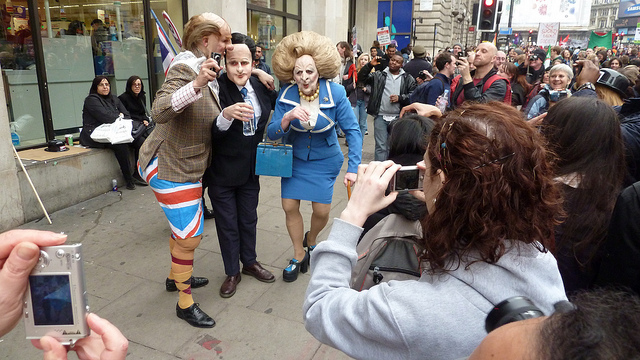Party environments shape the way that we, as citizens, think about politics
The UK’s two-party system is in steep decline, with the number of voters opting to back either Labour or the Conservatives dwindling, and parties such as UKIP, the SNP, and the Greens threatening to alter Britain’s electoral architecture. But how do party environments shape the way we think about politics? April A. Johnson argues that when the public are ambivalent about the parties which dominate political debate, it can have unpredictable and often conflicting effects on political engagement more widely.
London Permaculture, CC BY NC SA 2.0
The environment you find yourself in shapes the decisions you make. Retailers know this. Those tempting sweets in the grocery store checkout line or that soft music at the bookstore encourage customers to consume. But what about political environments? Do they have the power to shape the way in which ordinary citizens think about and engage with politics? This is the driving question behind my research on partisan ambivalence and political engagement.
Recently published in Political Studies, this article sought to understand whether partisan ambivalence, feeling unsure about or torn between two or more political parties, has the same effects on participation in Great Britain as it does in the United States. Prior research within the United States has indicated that feeling ambivalent towards the Democratic and Republican Parties leads to a decline in individual political activity. But is not clear as to whether this pattern of behaviour holds across various political environments.
I argue that by virtue of living within dissimilar political environments, citizens will come to perceive, process, and interact with politics in dissimilar ways. Broadly stated, contextual influences shape the very meaning of psychological constructs like ambivalence. Moreover, if the way in which one experiences partisan ambivalence is unique to their environment, this might seemingly result in ambivalence having differential effects on political involvement.
Using data from the 2005 U.K. General Election and data from the 2004 U.S. General Election I test this theory. Partisan ambivalence, as measured by feeling thermometer ratings towards the two major parties, is used to predict a seven item battery of political engagement. Engagement here includes activities such as contacting a political official, persuading others to vote, participating in campaign activities, as well as voting in the current and last election. Overall, I find that ambivalence has a predictable effect on political involvement in the United States. Specifically, across all U.S. Congressional districts the effect of ambivalence on engagement is always negative, meaning the more ambivalent one feels towards the two major parties the less likely they are to be politically active.
More interesting is that of the British context, where the effect of ambivalence is non-uniform across Parliamentary constituencies. Ambivalence was shown to have a negative impact on political engagement in some constituencies, such as Cambridge, North Dorset, Dumfriesshire, Clydesdale & Tweeddale, Ludlow, and Norwich South. In contrast, ambivalence had a positive impact, meaning greater levels of ambivalence increased political engagement, in areas like North Essex, South Ribble, Tewkesbury, Huntingdon, and Yeovil. Though the impact was not statistically significant in some of these cases, the fact that partisan ambivalence elicits both more and less political involvement is indeed an interesting, if not puzzling, finding.
The same psychological experience has varying effects on behaviour across constituencies. How can we explain this? My research shows that differential effects across Parliamentary constituencies was not due to demographic, economic, or partisan factors. That is to say, whether ambivalence equated to more or less political activity was not systematically related to the racial composition of the area, differences in income or unemployment, or the partisan make-up of the constituency. Instead, the answer to this variation appears to lie in the number of parties vying for election.
Constituencies that saw competition between a greater number of parties, such as Cambridge and Norwich South, also tended to be those districts in which feeling ambivalent dampened engagement. In other words, districts that were ‘crowded’ with electoral contenders were likely to see a heightened, negative impact of ambivalence on political activity. Given that my measure of political participation include not only voting but demanding activities like persuading others to vote, contacting political officials, and participating in campaign activities, it may not be so surprising that ambivalent individuals are not willing to put forth the effort in crowded electoral environments.
This finding appears logical if we consider that within most modern democracies parties serve as the central component of political life. In general, political parties represent a cohesive set of beliefs. Individual political figures and candidates are talked about in terms of their party affiliation. When ordinary citizens think of their political orientation or leaning they often speak in terms of party labels. Parties are how we make sense of the political world. What is more, parties are an enduring aspect. We expect them to organize our political choices year after year, election after election. Thus, party structure, and in particular local party dynamics, over time frames the way in which individuals think about politics.
Certainly, however, this is not to say that parties are the only contextual factor which matter. National political structure, particularly electoral rules, are sure to organize the way in which people contemplate and engage with the political environment. Recall that while partisan ambivalence had a varied- and party dependent- influence in the U.K. it always dampened engagement within the United States. This is true in districts where only one party received a percentage of the vote share in 2004 (e.g., New York’s 6th District) and in districts where six parties earned some percentage of the vote share (e.g., New Jersey’s 2nd District). Here, the level of electoral ‘crowding’ did not change how ambivalence impacts political involvement. Thus, it appears that macro-level and micro-level political dynamics are influential.
In all, my research finds that feeling ambivalent about politics sends various signals. Electoral rules and the number of competing parties may hold the key as to how individuals interpret this feeling. In certain political contexts, acknowledging that one feels ambivalent might signal a genuinely competitive race composed of quality opponents. In other contexts ambivalence might be attributed to apathy, where all competing parties are deemed to be of low quality. I suspect that the latter case is likely to depress, rather than motivate, individual political activity. Intriguingly, this line of research suggests that attitudes held in one environment might operate very differently in another environment.
Do political moderates evaluate policy in the same way as strong partisans? Are political sophisticates more likely to recognize and engage in strategic voting? These relationships surely hinge upon the structure of one’s political environment. While the electoral systems of the U.S. and the U.K. vary quite a bit in terms of voter registration laws, primaries, and even the date elections are held, it is my hope that this study will usher in a flood of comparative research. To the extent that comparative contexts remain unstudied, researchers may never fully grasp the entirety of partisan ambivalence, of partisan affiliation, or of any other individual-level variable essential for determining political outcomes.
—
Note: This article gives the views of the authors, and not the position of Democratic Audit UK, nor of the London School of Economics. Please read our comments policy before commenting.
—
 April A. Johnson is a Visiting Assistant Professor of Political Science at the University of Illinois at Chicago. Her research focuses on American electoral behavior, parties and elections, political psychology, mass media, and experimental methods.
April A. Johnson is a Visiting Assistant Professor of Political Science at the University of Illinois at Chicago. Her research focuses on American electoral behavior, parties and elections, political psychology, mass media, and experimental methods.






 Democratic Audit's core funding is provided by the Joseph Rowntree Charitable Trust. Additional funding is provided by the London School of Economics.
Democratic Audit's core funding is provided by the Joseph Rowntree Charitable Trust. Additional funding is provided by the London School of Economics.
Party environments shape the way that we, as citizens, think about politics – Democratic Audit UK: Democ… https://t.co/XPyLHXBAp8 #news
Check out my article: Party environments shape the way that we, as citizens, think about politics https://t.co/DWwNLCq6Tm @democraticaudit
“Party environments shape the way that citizens, think about politics”, says @AprilAJohnson: https://t.co/urS1p1U2hh
RT @PJDunleavy: Party environments shape the way that we, as citizens, think about politics https://t.co/SxVTtzwuMz
Party environments shape the way that we, as citizens, think about politics https://t.co/u4o5yHNBEy